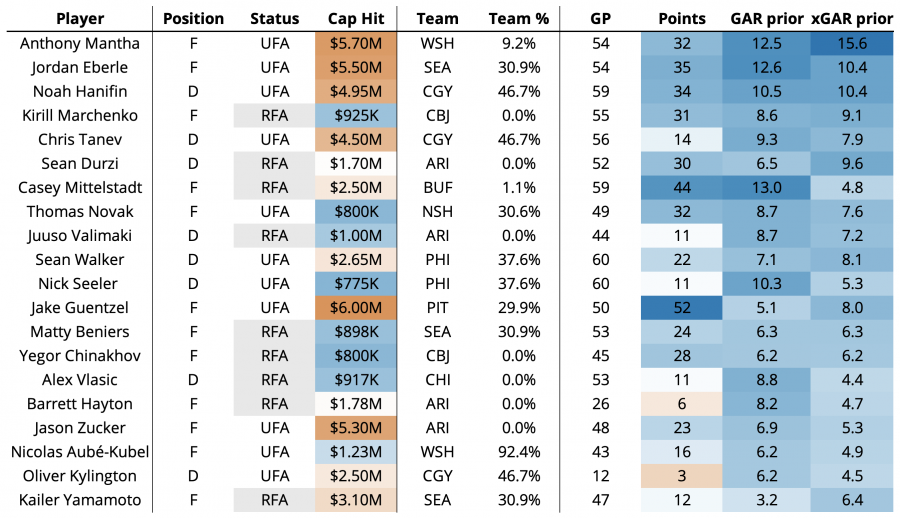The NHL trade deadline for the ’23-24 season is a week from tomorrow (March 8, 2024). We here at Evolving Hockey have developed a tradition of covering many of the annual events related to the NHL within a given calendar year (free agency, playoffs, player & team projections, expansion drafts, etc.). However, one of the biggest days of the year has, so far, lacked coverage by this site, or, at the very least lacked coverage via our patented data-and-models-only-no-narrative approach. I’m not entirely sure why it never occurred to us that this might be a fun thing to do, so I apologize for the lack of this fun thing in the past.
We thought it would be an interesting exercise to create our very own Big Board for this year’s trade deadline. That is: what if we took all of the data we have at our disposal, filtered it and joined it appropriately, and arrived at a list of players that would be the best targets for contending teams based strictly on the data. Well, that’s what we did. There’s a little bit of the narratives involved here, but aside from Henrique (he’s a narrative include), this is our best estimation of which players contending teams should target.
The Process
To start, we’re using CapFriendly’s amazing contract data to determine “player availability” for this exercise. We’re first targeting all players currently signed to a contract that will expire at the end of the ’23-24 season. This is our baseline. From this, we will remove several different groups of players who will likely be unavailable for acquisition over the next week or so. The following groups of players have been excluded:
- Any player that signed a contract extension midseason (38 total players)
- Any player that has already been traded this season (24 total players)
- It’s possible we may see one of these players traded, but for simplicity we are not including them here
- Any player with an expiring contract that didn’t play in either the ’22-23 or ’23-24 season (this includes any player currently playing in their first NHL season)
- Any player currently playing on a team with a probability of making the playoffs above 50% per our team projections
- As of publication, the following teams currently meet this criterion: CAR, NYR, N.J, FLA, BOS, TOR, DET, T.B, DAL, WPG, COL, VAN, EDM, VGK, L.A
With these criteria set, we can move on to our trade targets.
The Big Board
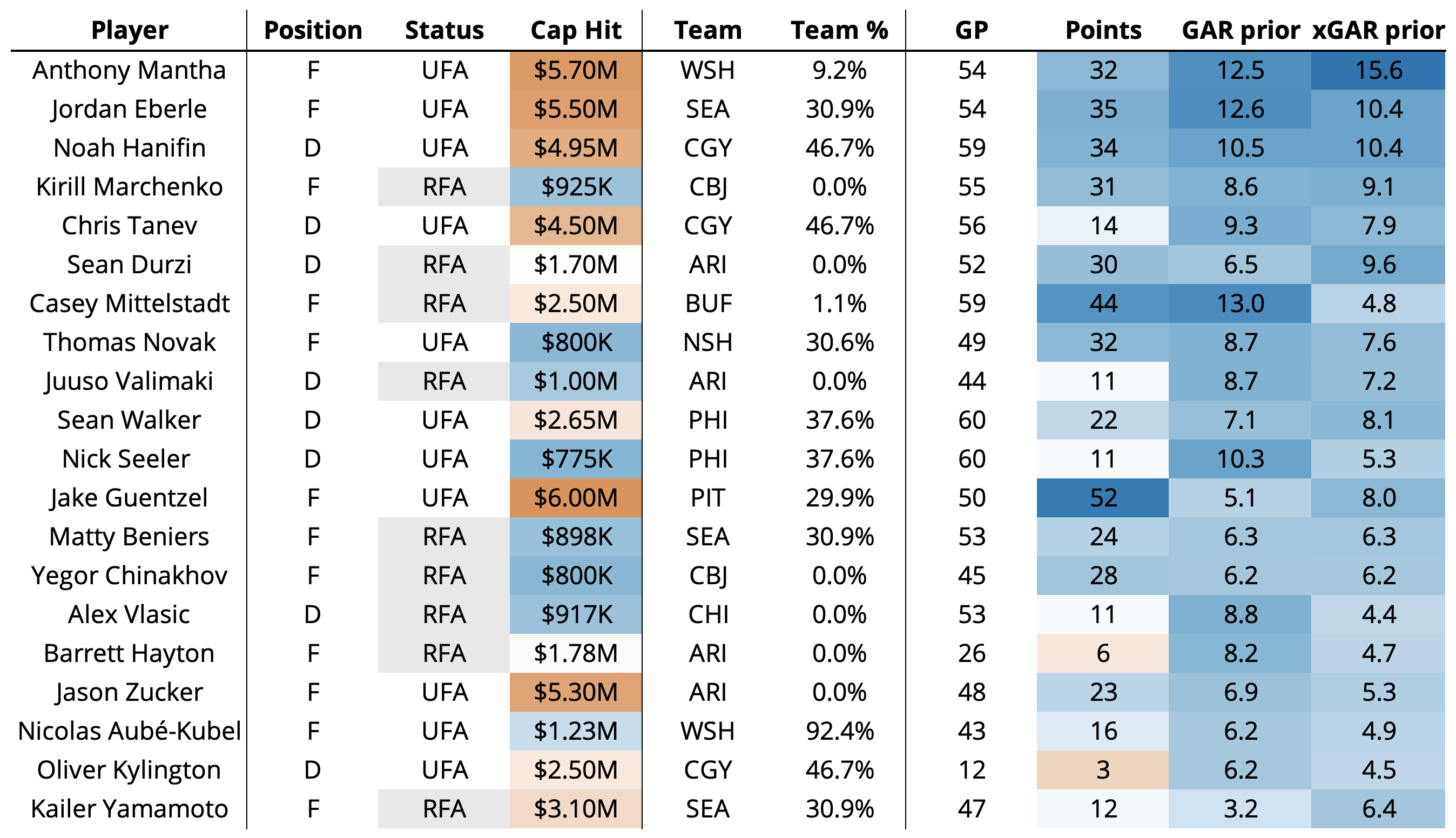
Here are the top-20 players, sorted by a somewhat loosely weighted average (6/4/2) of their prior 2- or 3-year GAR and xGAR metrics. ’23-24 data has been prorated to a full season to allow this weighted average to function correctly. Of note: the correlation between GAR and xGAR is quite strong, so there are only a few players who differ much between the two (Mittelstadt, Seeler). Admittedly, the methodology here is a bit crude – a possible “better” way to arrive at a more stable or reliable metric for this purpose would be to build a projection model and predict either next-season or rest-of-season performance. However, for our purposes, this gives us a solid list of players who have performed well by our metrics over the past few years.
Of note, goalies were not included here (sorry goalies). Goalies are historically difficult to predict, and it’s actually quite rare that a big-name goalie is traded heading into the deadline. Based on some personal research of the consensus among media sources, it appears Jacob Markström, Juuse Saros, and Jake Allen are the possible targets there. To be honest, I’m skeptical enough of these to be begin with, but the Devils should totally go get Markström. Also of note: it’s unlikely we’ll see many RFAs moved at all (although we’ve seen more of this in recent years), but I have included them above for reference. Ok onto the targets.
The Players
Anthony Mantha
When researching and building out this list, it was bit surprising to see Mantha at the top. Not because I wasn’t aware that he has been quite good for his entire career – I just didn’t realize he may even be available. I’m still not sure if he is, but he tops our list of targets for teams looking to add at the deadline. Mantha’s currently in the middle of his strongest season per our xGAR model (16.4 total through only 67 games), and he grades out surprisingly well over the last few seasons (hell, his whole career really). His shooting value this season is what’s driving the majority of his ’23-24 success, but he is once again putting up solid rates for, quality for, and defensive numbers to back this up from a RAPM and GAR view. Mantha has never been a below-replacement defensive player, and any team looking for a very solid two-way player would be hard-pressed to find a better option this deadline. His $5.7M contract may make it difficult for certain teams to fit him in, but if he’s available, he’ll make an immediate impact for any contender.
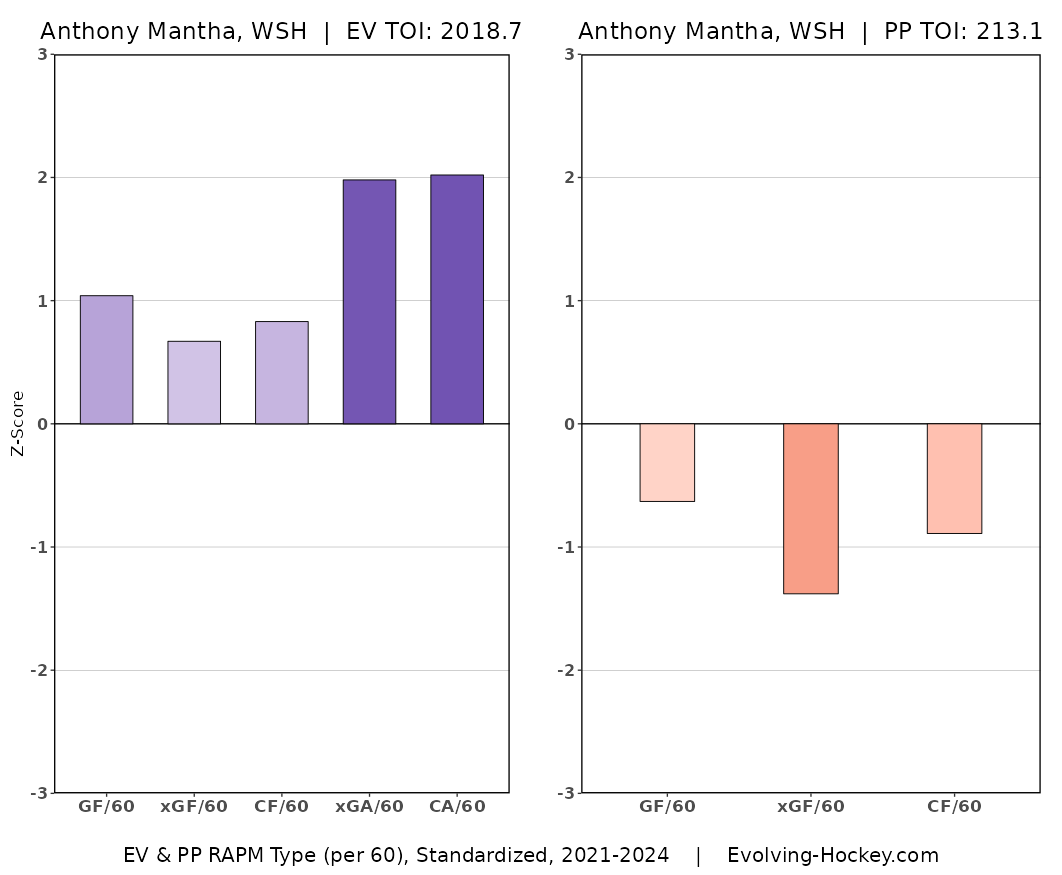
Jordan Eberle
Jordan Eberle may just be our most enticing trade deadline target. The Seattle Kraken aren’t out of the playoff picture just yet, but with limited time left and a bright future ahead of them, the Kraken are likely sellers at the deadline. Eberle will turn 34 in May, but he hasn’t shown any serious signs of aging. His 4.1 SPAR and 3.3 xSPAR place him in the upper tiers of the league. He’s also not just an “analytics darling” on the fourth line who makes their impact defensively (we’ll get to that later). He plays alongside Matty Beniers and Jared McCann, who made up one of the best offensive lines in the league last season. A team could pretty confidently find a spot for him to compliment a center and winger in their top nine. If you place any value on it, he has also been on deep playoff runs to the conference finals. His $5.5 million salary may be difficult for a competing team to take on, but Seattle would almost certainly be willing to retain in order to continue to stock pool picks and prospects.
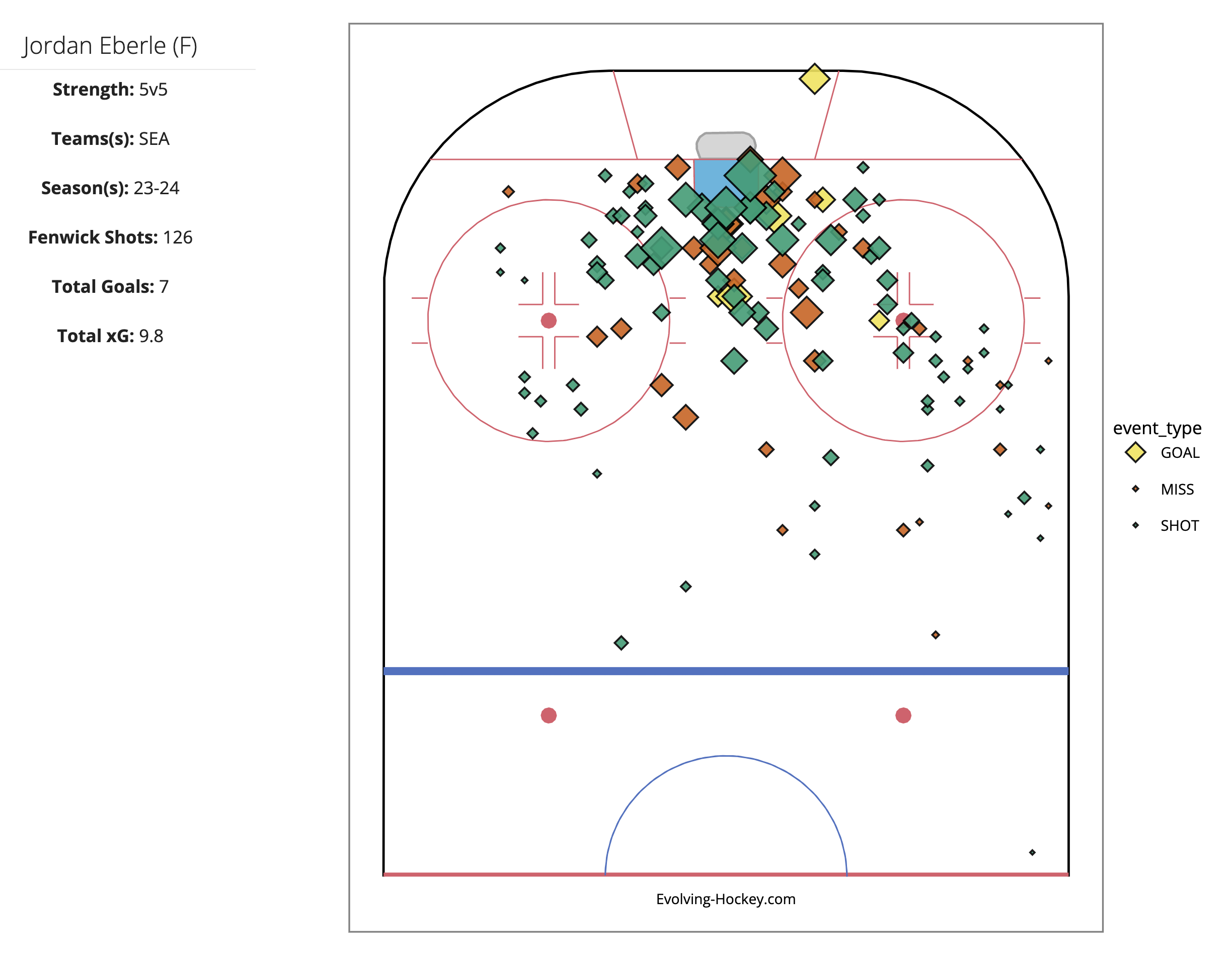
Noah Hanifin
It feels like the Calgary Flames have been at the heart of the trade deadline discussion since November. Noah Hanifin was acquired by the Flames with Elias Lindholm in the summer of 2018. Lindholm was recently traded away without showing any intention of re-signing, so it would only seem fitting that Hanifin will do the same. One thing that flies under the radar is how volatile Hanifin’s numbers have been throughout his career. 2021-22 was his career-season with 48 points, 5.0 SPAR and 5.4 xSPAR, and he’s not far off from matching those marks this season. However, for the remainder of his career he’s bounced around between average and replacement level. That definitely does not match the narrative. Maybe it’s a problem caused by his environment – I mean we’ve all been trying to figure out the Flames these last few years, but with that in mind, a team trading for him should do extra due diligence.
Chris Tanev
Note: This trade happened within minutes of writing. We discussed this on the podcast. The Dallas Stars got even better defensively and the price for Tanev seemed to be a bit low considering the retainage.
In our research, Chris Tanev is the highest consensus trade target still in play. He doesn’t have the offensive acumen of his defense partner, and fellow deadline target, Noah Hanifin, but his defensive play is … stellar. There haven’t been too many stay-at-home defensemen that have been loved by both the scouts and nerds quite like Tanev. Over the years, both the GAR and xGAR models have seen him as a solid top-four defenseman with almost all of his impact coming from defensive play. This hasn’t been his strongest season with 1.6 SPAR and 0.8 xSPAR, but that’s nothing that would take him out of the conversation of being a good acquisition for most playoff teams. The knock on his value is that at 34 years old, he’ll likely just be a rental. With a shift towards wanting to extend deadline acquisitions, some younger defensemen may move at higher price points relative to the value they can bring now on the ice.

Casey Mittelstadt
Mittelstadt is the only RFA we’re including here, and I think he warrants legitimate consideration as a possible target for teams. Acquiring expiring RFAs at the deadline (or really at any point) is tricky, and any acquisition ensures a team will need the cap space and, I suppose, “plan” to add said player for multiple years. Mittselstadt isn’t making this easier with his confusing career. Roughly replacement-level for multiple seasons before this year and last, he’s a bit of a conundrum. I suppose some of this has to do with the conundrum that is the Sabres and the many organizational and systematic changes during his tenure. Regardless, Mittelstadt has been one of the Sabres best players this season. Our models don’t necessarily agree on how effective he’s been, or rather, what’s driving this effectiveness. One trend does seem to hold however: his defense has greatly improved this year; it’s possible the Sabres’ defense-first switch this season, which seems to have caused problems throughout much of their lineup, may in fact be helping him. Regardless, at 25 years old with the possibility of a smaller $ contract extension, Mittelstadt may just be worth the gamble for a contending team looking towards the future.
Sean Walker
Talk about an interesting player. Traded by the Kings to Philadelphia last summer as part of the Cal Petersen cap-dump, the Flyers acquired a defenseman that has turned into arguably one of their best players this season; no current Flyer tops his 11.4 xGAR, and his RAPM C±/60 of 8.41 is top-10 among all players in the league with at least 300 minutes. Now, I think we need to acknowledge Philadelphia’s part in his success here. While Walker has been mostly solid in the past, none of his prior seasons even come close to what he’s doing this season. Historically, he’s never been especially strong defensively, and whether he can continue his new performance with a different team is a legitimate question teams should ask themselves. But if he produces at even 70% of what he’s doing with the Flyers this year, he’d be a great depth-option for any contending team. With a cap hit of only $2.65M and Chris Tanev off the market, Walker may just be the best D option for teams looking for cheap depth.
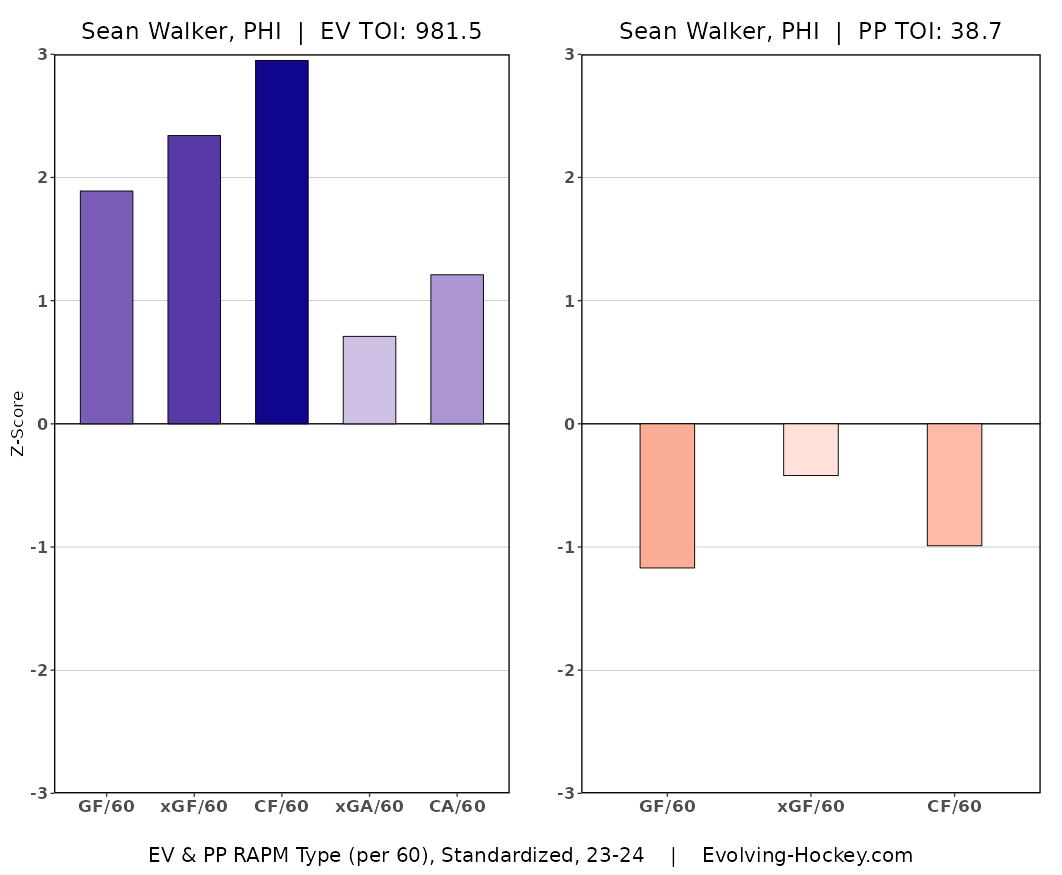
Nick Seeler
The Flyers are the only team here that get two players. And it’s not even clear that they’ll be sellers at the deadline, sitting oddly in 3rd place in the Metroplitan division at the time of writing. However, our simulations seem fairly convinced they’ll fall out of a playoff position, and given this was supposed to be a strong rebuilding year with little playoff aspirations, it seems likely they’ll be moving at least a few players. Nick Seeler is a name near and dear to my heart. As one of the first “busts” in the fledgling days of EvolvingWild, I was convinced Seeler was going to be the next Jonas Brodin. That didn’t happen. But … maybe? Like I said with Walker, I don’t know what the hell is going on with the Flyers’ system. Seeler was practically out of the league (he didn’t even play in the ’20-21 NHL season) before Philadelphia signed him heading into the ’21-22 season and then extended him for two more years. Few players have shown a consistent ability of limiting expected goals against while allowing above-average shot rates against like Seeler (four of his six seasons show this per our RAPM models. Reminder: that means he’s allowing a lot of shots against, but they’re not particularly dangerous). Seeler isn’t going to blow fanbases away as an acquisition – he may not even get a headline depending on the team. But it seems he’s figured out a good way to drive down goal probability while on the ice, and that’s always valuable for competing teams.

Jake Guentzel
Jake Guentzel may be perceived as the best player available if he is, in fact, available. The Pittsburgh Penguins are in a precarious spot fighting for their playoff lives in the East. With Sidney Crosby, Evgeni Malkin, and Kris Letang still a part of the team, it’s hard to see them as sellers at the deadline. However, with Fenway Sports Group recently taking ownership and the hiring of “forward-thinking” Kyle Dubas, there may be a chance for something new. Guentzel had his breakout season in 2018-19 where he scored 40 goals and posted 5.5 SPAR / 9.1 xSPAR. From there, he was always good offensively, but a severe decline in his defensive play in ‘21-22, which continues to persist, brought his overall value down greatly. One point to make is that he is having a down year, shooting 11.9% compared to a career-average of 15.2%. That may help reduce the asking price for a two-time 40-goal-scorer. Also, if you are negotiating with Kyle Dubas, maybe mention that he’s spent over 90% of his 5v5 minutes with Sidney Crosby over the last two seasons. Just a thought.
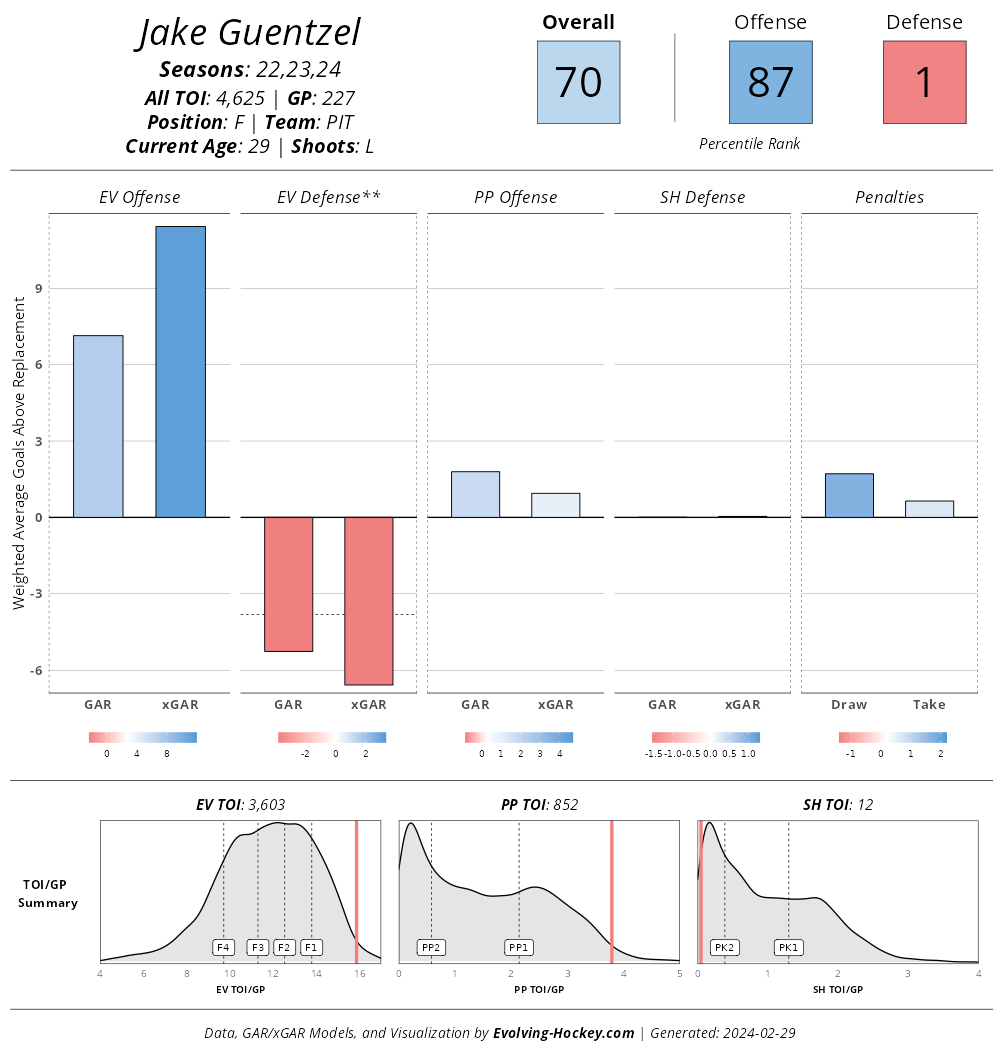
Adam Henrique
Note: Henrique is 26th on the Big Board, but we decided to write about him anyway.
It looks like Adam Henrique may head back east. Lest we forget his rookie season (especially the playoffs) with the New Jersey Devils. Henrique just turned 34 in February and is on an expiring contract. It is very unlikely that he will return to the rebuilding Ducks, and therefore will certainly be dealt. In fact, as I write this, I fear he may get dealt before this goes out. There appears to be a strong disconnect between Henrique’s points (38 in 57 games) and his SPAR and xSPAR (1.1 and 0.4 respectively). Potentially in his defense (no pun intended here), some of that is due to poor defensive play. While we wouldn’t normally make any exceptions, it’s been really hard to pick out how much everyone has contributed to the defensive mess in Anaheim (which has improved this season!). Still Henrique’s poor defensive numbers do go back to his New Jersey days. If you are looking for a center who could potentially score a few goals for you in a third line role, you could do worse. And luckily for Anaheim, there really isn’t another center on the market.
Thomas Novak
To be honest, I’m not entirely sure I even knew who this person was before he popped up on our Big Board. Isn’t that just the perfect example of what fun a data-first approach can provide! I suppose I should know who Thomas Novak is given he’s a good ol’ Minnesota boy. Playing a pure-depth role with the Predators over the last three seasons, Novak has proven quite serviceable this season marked by some surprising offensive contribution as a borderline top-unit powerplay center. Like Seeler, Novak isn’t increasing the font size on any headlines, and his horrendous defensive season last year (6th worst among all players in xEVD) should give pause to teams, but a depth forward that can step into second-unit powerplay minutes isn’t nothing. We’re also running out of options here because I’m definitely not talking about Tarasenko as a good deadline target for teams. [Moneyball voice] the guy sounds like an Evolving Hockey already.
Conclusion
And with that, it’s time to update the Big Board as the next week evolves. This is the first year we’ve done something like, so I can’t speak to how this year’s deadline class compares to previous years. Given that some of the “big” names have already been moved, it wouldn’t surprise me if this deadline feels a bit unimpressive to most. However, there are quite a few players that have gone under-the-radar in trade speculation, and several contenders are primed to make good additions assuming they have the ability and space. I’m personally excited to see how any of our “targets” pan out. Remember, we’re not predicting anything here, but if any of these players make a big impact in the playoffs and become a major storyline, then we definitely predicted that and got it right.
